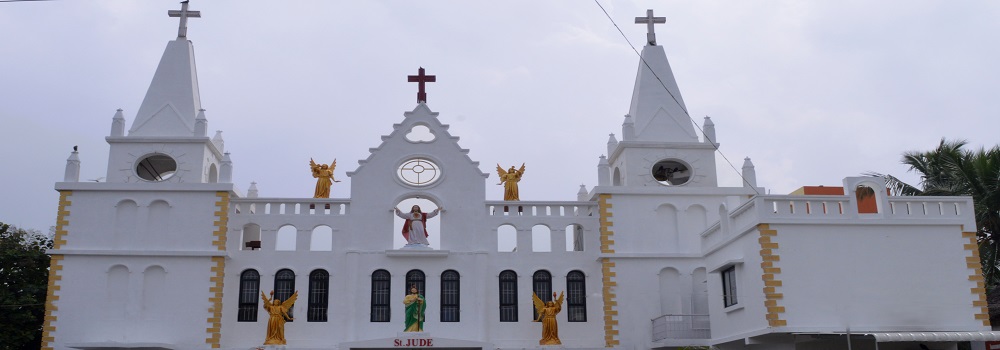The only church in the diocese of Chingleput dedicated to St.Jude’s is the church at Vanuvampet. Its Patron, St.Jude is the cousin of our Lord Jesus Christ and the patron saint of hopeless cases.
Our Church was declared as a Pilgrimage Shrine by the Diocese of Chengalpet in the Jubilee year of Divine Mercy 2016 and on 28-October-2018, our Pilgrimage Shrine was elevated to Diocesan Shrine by Most Rev.Dr.Anthonisamy Neethinathan, Bishop of Chingleput
During the period between 1973 and 1977, the residents of this area often travelled to nearby parishes for their religious activities. It was around this time that Rev. Fr. Mathew, the parish priest of St. Thomas Mount, together with a local devotee named Mr. Arokiam from Nanganallur, established a prayer hall.
Rev. Fr. Phillips, OMZ, helped purchase this holy pit of land. Mayilai Bishop Rt.Rev. R. Arulappa provided the remaining financial aid.
Rev.Fr.George Thakkadam, the Adambakkam parish priest accepted further funds and established this church in 1975. He humbly requested this church to be dedicated to St.Jude. Rt.Rev.Bishop Arulappa consecrated this church with a fervent dedication to St.Jude as its Patron.
The devotion to St.Jude began to spread in and around Vanuvampet. Bishop Rt.Rev.Cashmir Gnanadickkam helped the further development of our church.
In 1997, Adambakkam parish priest Rev.Fr.Joseph Manickam, restructured and renewed the church. The auxiliary Bishop Rt.Rev.Lawrence Pious consecrated the church.
In 2005 our Bishop Rt.Rev.Neethinathan announced our St.Judes Church as a Quasi parish. In 2006 our church was announced as a new parish.

Rev.Fr.G.M.Joseph became our First parish priest.
In 2009, Rev.Fr.Terry Stephen took charge as our Parish Priest on 30.05.2009. As the devotion towards St.Jude steadily, special novena masses on the first Thursday of every month was introduced at 11AM. On every first Sunday at 11AM special novena mass is celebrated in English for the devotees of St.Jude. Lunch is also provided to all the faithful after the mass.
Under the direct supervision of Rev.Fr.Terry Stephen and Rev.Fr.Pravin, the church has risen to its new height with charming beauty and a new look. This renovated sanctuary of hope and love, blessed and consecrated on the 17/10/2013 by our Rt.Rev.Bishop Dr.Neethinathan.


In 2014, Rev.Fr.Michael Suresh took charge as our parish priest on 07/06/2014.
Our Church is declared as a Pilgrimage Shrine – Diocese of Chengalpet in the Jubilee year of Divine Mercy 2016.
On 28-October-2018, our Pilgrimage Shrine has been elevated as Diocesan Shrine by Most Rev.Dr.Anthonisamy Neethinathan, Bishop of Chingleput.
Rev.Dr.Martin Joseph took charge as Rector & Parish Priest on July 6th, 2019.


Rev.Dr.I.Antony Raj took charge as Rector & Parish Priest on May, 2024.
